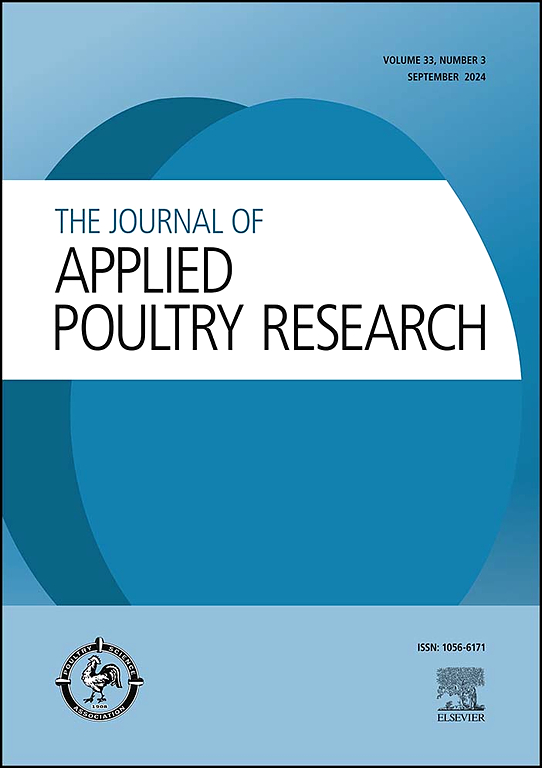应用研究说明:评估用于清洁鹌鹑饲养设施的压缩空气泡沫系统
IF 1.6
3区 农林科学
Q2 AGRICULTURE, DAIRY & ANIMAL SCIENCE
引用次数: 0
摘要
有效的清洁和卫生规程对于减轻家禽饲养设施中的疾病暴发非常重要。这在沙门氏菌病病例中尤其重要,因为沙门氏菌病有向人类传播疾病的风险。压缩空气泡沫系统(CAFS)可以作为发泡剂的替代载体,在爆发后清洁和消毒农业表面。本研究的目的是评价CAFS应用商业消防泡沫(FF)和氯基泡沫清洁剂(FC)在有沙门氏菌病史的地板围栏和笼养鹌鹑设施中的效果。灭火泡沫浓缩物(Phos-Chek WD881)和泡沫清洁剂(cl -A- foam XL)在水中稀释,并使用压缩空气泡沫系统将其应用于地板围栏和笼式饲养设施。用拭子定量处理前后的总需氧菌和细胞三磷酸腺苷(ATP)。两种处理均显著降低了地板围栏和笼式鹌鹑设施中的需氧细菌(P <;0.05)。据报道,在氟氯烃处理后,地板笔设施的最大降幅为1.74 log10 CFU/mL。在地板围栏和笼型鹌鹑设施中,CAFS施用FF和FC也显著降低了微生物ATP水平(P <;0.05)。用FF处理地板笔设施导致最大的ATP减少4,201 RLU。这些数据总结了CAFS应用发泡剂的效果,表明压缩空气泡沫系统可以作为一种实用的方法来清洁鹌鹑饲养设施。本文章由计算机程序翻译,如有差异,请以英文原文为准。
Evaluation of a compressed air foam system to clean quail rearing facilities
An effective cleaning and sanitation protocol is important to mitigate disease outbreaks in poultry rearing facilities. This is especially important in cases of salmonellosis where there is a risk of disease transmission to humans. Compressed air foam systems (CAFS) may serve as an alternative carrier for foaming agents to clean and sanitize agricultural surfaces following an outbreak. The objective of this study was to evaluate the effects of a CAFS applied commercial firefighting foam (FF) and chlorine-based foaming cleaner (FC) in floor pen and caged quail rearing facilities with a history of salmonellosis. A firefighting foam concentrate (Phos-Chek WD881) and foaming cleaner (Chlor-A-Foam XL) were diluted in water and applied to floor pen and caged rearing facilities using a compressed air foam system. Total aerobes and cellular adenosine triphosphate (ATP) were quantified pre- and post-treatment using swabs. Both treatments significantly reduced aerobic bacteria in the floor pen and caged quail facilities (P < 0.05). The greatest reduction of 1.74 log10 CFU/mL was reported in the floor pen facility following FC treatment. Microbial ATP levels were also significantly reduced by both the CAFS applied FF and the FC in the floor pen and caged quail facilities (P < 0.05). Treatment of floor pen facilities with the FF resulted in the greatest ATP reduction of 4,201 RLU. These data summarize the efficacy of CAFS applied foaming agents suggesting that a compressed air foam system may serve as a practical method to clean quail rearing facilities.
求助全文
通过发布文献求助,成功后即可免费获取论文全文。
去求助
来源期刊

Journal of Applied Poultry Research
农林科学-奶制品与动物科学
CiteScore
4.10
自引率
10.50%
发文量
80
审稿时长
104 days
期刊介绍:
The Journal of Applied Poultry Research (JAPR) publishes original research reports, field reports, and reviews on breeding, hatching, health and disease, layer management, meat bird processing and products, meat bird management, microbiology, food safety, nutrition, environment, sanitation, welfare, and economics. As of January 2020, JAPR will become an Open Access journal with no subscription charges, meaning authors who publish here can make their research immediately, permanently, and freely accessible worldwide while retaining copyright to their work. Papers submitted for publication after October 1, 2019 will be published as Open Access papers.
The readers of JAPR are in education, extension, industry, and government, including research, teaching, administration, veterinary medicine, management, production, quality assurance, product development, and technical services. Nutritionists, breeder flock supervisors, production managers, microbiologists, laboratory personnel, food safety and sanitation managers, poultry processing managers, feed manufacturers, and egg producers use JAPR to keep up with current applied poultry research.
 求助内容:
求助内容: 应助结果提醒方式:
应助结果提醒方式:


